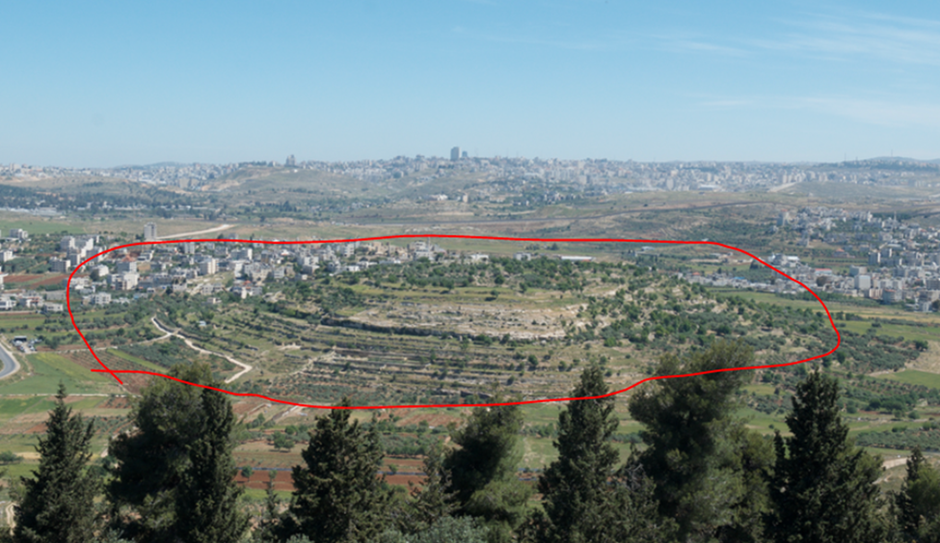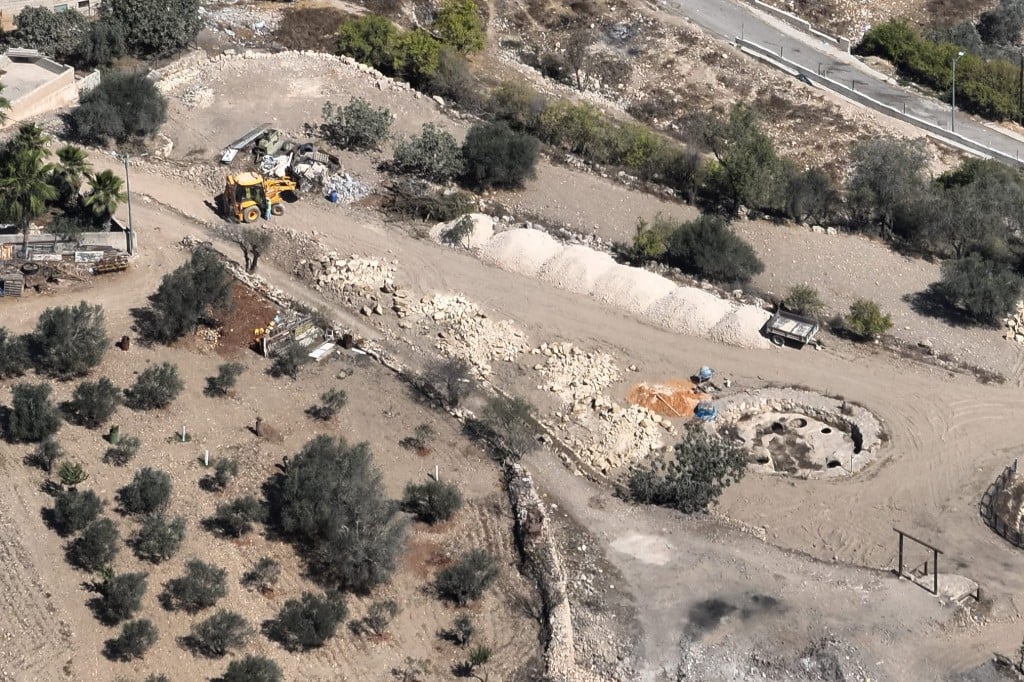Israeli authorities have halted what they described as a deliberate attempt by the Palestinian Authority (PA) to destroy one of the most important biblical and archaeological sites in Judea.
On Monday, IDF forces and the Binyamin Regional Council intervened after PA engineering crews began large-scale infrastructure work at the ancient site of Gibeon—known from the Bible as the city where Joshua made peace with the Gibeonites and where “the sun stood still at Gibeon, and the moon in the valley of Ayalon” (Joshua 10:12).

According to officials, excavators and construction materials were seized in a coordinated operation with the heritage protection group Guardians of Eternity, which first identified the illegal work. The crews were reportedly preparing to pour concrete, clear ancient terraces, and lay asphalt—actions that experts warned would cause irreversible damage to the 3,000-year-old site.
“This is infrastructure work using heavy mechanical tools in the heart of the site, near the most important elements of the mound,” explained Adi Shargai, director of activities for Guardians of Eternity.
“Concrete pouring and clearing of terraces from the ancient stones of the site were identified. Piles of bedding ready for spreading and paving asphalt were scattered throughout the area, as well as mechanical tools such as a roller,” she said.
The ancient city of Gibeon, located north of Jerusalem in the territory of the tribe of Benjamin, is among the most significant sites in biblical archaeology. It was described in Scripture as “the great city of Gibeon, one of the royal cities,” and later became one of the 13 priestly cities in Israel. It was also home to King Saul’s family and played a key role in his reign.
In the 1950s, American archaeologist James Pritchard led major excavations at the site, uncovering hundreds of wine cellars, an intricate water system, and pottery handles inscribed with the ancient Hebrew name Giv’on—a direct confirmation of the biblical city’s identity.
The site’s most famous feature is the massive circular pool mentioned in the Book of Samuel, believed to be part of the city’s water system, which remains connected to a natural spring to this day.
Despite being located in Area C, where Israel maintains full security and administrative authority, Gibeon’s proximity to the Palestinian village of Al Jib and its position outside the Jerusalem security barrier have made it difficult to protect.
“During the construction of the seam barrier, the site was left outside the fence, which exacerbated the problem of accessibility and supervision,” said Shargai. “Today, access requires complex coordination and security escort. Seizing the tools is an important step, but constant monitoring is essential to prevent future harm.”
Binyamin Regional Council head Yisrael Gantz accused the PA of engaging in systematic heritage destruction as part of a campaign to erase Jewish history and replace it with a false narrative.
“The same authority that the world wants to reform and entrust with responsibility for Gaza is once again proving its true nature,” Gantz said.
“This is a nationalist heritage attack aimed at erasing a biblical site. We will continue to fight with all our might to dismantle the Palestinian Authority and impose Israeli sovereignty over all of Judea and Samaria, including these sites that prove our exclusive right to the land of our ancestors.”
The attempt at Gibeon is part of a wider pattern of Palestinian efforts to destroy or rewrite Jewish history in the biblical heartland.
In recent years, the PA has been caught conducting unauthorized construction on Mount Ebal, where Joshua’s Altar is located, threatening to obliterate one of the most sacred and archaeologically verified sites of ancient Israel (as reported by TPS-IL in 2023).
Similarly, in Sebastia, the ancient capital of the northern Kingdom of Israel, PA bulldozers have been accused of damaging ancient walls and desecrating the ruins of the royal palace of King Omri, in what experts describe as an attempt to “Palestinize” the heritage site.
In 2017, Palestinian Authority bulldozers obliterated ancient Archelais in the Jordan Valley to construct the Arab city of Khirbet al-Buyudat directly over the archaeological site.
Dozens of other incidents have been documented by Guardians of Eternity and the Civil Administration’s Archaeology Staff Officer, including looting, illegal roadwork, and deliberate dumping of waste on heritage sites throughout Judea and Samaria.
The destruction accelerated dramatically following the 1993 Oslo Accords, which created Areas A and B under varying degrees of Palestinian Authority control. Archaeological excavations declined precipitously while vandalism and systematic looting increased.
Israel’s thriving antiquities market incentivizes grave robbing and site looting, with artifacts that survived millennia of foreign occupation now threatened under Jewish sovereignty. Ancient cemeteries suffer particular damage as looters target burial sites for saleable objects.
Judea and Samaria contain approximately 12,000 identified archaeological sites, making the region the world’s densest concentration of Jewish antiquities. Yet paradoxically, this archaeologically richest region remains the most neglected. Since Israel gained control of the territories in 1967, fewer than 10% of sites have received even partial excavation—approximately 1,000 sites compared to 9,000 excavated elsewhere in Israel. A comprehensive survey by Shomrim Al Hanetzach (Preserving Forever), an organization supported by the Israel Heritage Preservation Center, documented damage to 80% of significant archaeological sites in Judea and Samaria. The destruction stems from multiple sources: systematic Arab vandalism, antiquities theft, unsupervised construction, and agricultural encroachment.
Responsibility for safeguarding archaeological sites in Judea and Samaria currently lies with the Civil Administration’s Archaeology Staff Officer, but many Israeli lawmakers have argued for extending the jurisdiction of the Israel Antiquities Authority (IAA) to these areas.
MK Amit Halevy recently renewed calls for such a move, arguing that the current system lacks the authority and resources to prevent ongoing destruction. Critics, however, warn that such a change might further isolate Israeli archaeologists from international cooperation.
Despite international pressure, Israeli experts say the destruction of sites like Gibeon shows the urgent need for direct Israeli sovereignty and protection of Jewish heritage throughout Judea and Samaria.
“We must not abandon our heritage to those who wish to erase history using engineering tools,” Guardians of Eternity said in a statement.
“The stones of Gibeon, Mount Ebal, and Sebastia tell the story of our people’s covenant with this land. Their destruction is not just vandalism—it is historical warfare.”




